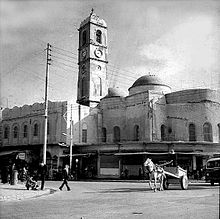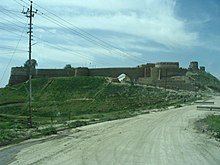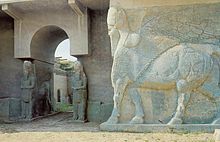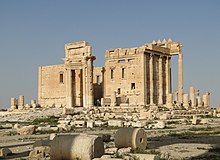Deliberate destruction and theft of cultural heritage has been conducted by the Islamic State of Iraq and the Levant since 2014 in Iraq, Syria, and to a lesser extent in Libya. The destruction targets various places of worship under ISIL control and ancient historical artifacts. In Iraq, between the fall of Mosul in June 2014 and February 2015, ISIL had plundered and destroyed at least 28 historical religious buildings. Valuable items from some buildings were looted in order to smuggle and sell them to foreigners to finance ISIS activities. By 23 March 2019, ISIL lost most of its territories in the Middle East, having been defeated in Iraq and Syria.
Motivation
ISIL justifies the destruction of cultural heritage sites with its following of Salafism which, according to its followers, places "great importance on establishing tawhid (monotheism)", and "eliminating shirk
(polytheism)." While it is often assumed that the group's actions are
mindless acts of vandalism, there is an ideological underpinning to the
destruction. ISIL views its actions in sites like Palmyra and Nimrud as
being in accordance with Sunni Islamic tradition.
Beyond the ideological aspects of the destruction, there are
other, more practical, reasons behind ISIL's destruction of historic
sites. Grabbing the world's attention is easily done through the
destruction of such sites, given the extensive media coverage and
international condemnation that comes afterwards. Destroying historic
ruins also allows ISIL to wipe the slate clean and to start afresh,
leaving no traces of any previous culture or civilization, while also
providing an ideal platform for the group to establish its own identity
and leave its mark on history. Despite the images showing extreme
destruction, ISIL has also been making use of the looted antiquities to
finance their activities. Despite the UN's ban on the trade of artifacts looted from Syria since 2011, the group has been smuggling these artifacts out of the Middle East and on to the underground antique markets of Europe and North America.
Destroyed heritage
Prophet Jonah (Nabi Yunus) Mosque in Mosul, pictured in 1999. It was destroyed by ISIL in 2014.
Mosques and shrines
In 2014, media reported destruction of multiple, chiefly Shiite, mosques and shrines throughout Iraq by ISIL. Among them were the Al-Qubba Husseiniya Mosque in Mosul, Sheikh Jawad Al-Sadiq Mosque, Mosque of Arnā’ūt, Mosque of Qado, Mosque of Askar e- Mullah and Saad Bin Aqeel Shrine in Tal Afar, Sufi
Ahmed al-Rifai Shrine and tomb and Sheikh Ibrahim shrine in Mahlabiya
District and the so-called Tomb of the Girl (Qabr al-Bint) in Mosul.
The Tomb of the Girl, reputed to honour a girl who died of a broken
heart, was actually believed to be the tomb of medieval scholar Ali ibn al-Athir.
In June 2014, ISIL bulldozed the two buildings in the complex of the shrine of Fathi al-Ka'en.
On 24 September 2014, the Arba'een Wali Mosque and Shrine in Tikrit, containing forty tombs from the Umar era, was blown up. On 26 February 2015 ISIL blew up the 12th century Green Mosque in central Mosul.
In Mosul, ISIL also targeted several tombs with shrines built over them. In July 2014, ISIL destroyed one of the tombs of prophet Daniel (located in Mosul) by planted explosives. On 24 July 2014, the tomb and mosque of the prophet Jonah was destroyed with explosives. On 27 July, ISIL destroyed the tomb of Prophet Jirjis (George).
On 25 July 2014, the 13th-century shrine of Imam Awn al-Din in Mosul, one of the few structures to have survived the 13th-century Mongol invasion, was destroyed by ISIL. The destruction was mostly carried out with explosive devices, but in some cases bulldozers were used.
In March 2015, ISIL reportedly bulldozed to the ground the Hamu
Al-Qadu Mosque in Mosul, dating back to 1880. The Hamu-Al-Qadu mosque
contained an earlier tomb of Ala-al-din Ibn Abdul Qadir Gilani. In the same year ISIL ordered the removal of all decorative elements and frescoes from mosques in Mosul, even those containing Quranic verses that mention Allah. They were regarded by ISIL as "an erroneous form of creativity, contradicting the basics of sharia." At least one imam in Mosul opposing that order was shot to death.
Leaning minaret of the Great Mosque of Al-nuri. Destroyed by ISIL on 22 June 2017 during the Battle of Mosul.
ISIL also destroyed Sufi shrines near Tripoli, Libya, in March 2015. The shrines were destroyed by sledgehammers and bulldozers.
In June 2015, it was announced that ISIL had blown up the ancient tombs of Mohammed bin Ali and Nizar Abu Bahaaeddine, located close to the ruins of Palmyra.
In 2016, ISIL destroyed the Minaret of Anah located in Al Anbar Province, which dates back to the Abbasid era. The minaret was only rebuilt in 2013 after the destruction by an unknown perpetrator in 2006.
In 2017, ISIL destroyed the Great Mosque of al-Nuri and its leaning minaret. This was the mosque where ISIL leader Abu Bakr al-Baghdadi declared the establishment of the Islamic State caliphate three years prior.
Churches and monasteries
Dair Mar Elia monastery, which was destroyed sometime between late August and September 2014
In June 2014, it was reported that ISIL elements had been instructed to destroy all churches in Mosul. Since then, most churches within the city have been destroyed.
- The Virgin Mary Church was destroyed with several improvised explosive devices in July 2014.
- Dair Mar Elia, the oldest monastery in Iraq, was demolished sometime between late August and September 2014. The destruction went unreported until January 2016.
- The Al-Tahera Church, built in the early 20th century, was possibly blown up in early February 2015. However, there is no evidence that the church was actually destroyed.
- St Markourkas Church, a 10th-century Chaldean Catholic church, was destroyed on 9 March 2015, according to the Iraqi government official Dureid Hikmat Tobia. A nearby cemetery was also bulldozed.
- Another church, which was reportedly "thousands of years" old, was blown up in July 2015. According to Kurdish sources, four children were inadvertently killed when the church was destroyed.
- The Sa'a Qadima Church, which was built in 1872, was blown up in April 2016.
The Sa'a Qadima Church in Mosul, blown up in April 2016
ISIL also blew up or demolished a number of other churches elsewhere in Iraq or in Syria. The Armenian Genocide Memorial Church in Deir ez-Zor, Syria was blown up by ISIL militants on 21 September 2014.
On 24 September 2014 ISIL militants destroyed with improvised explosive devices the 7th-century Green Church (also known as St Ahoadamah Church) belonging to the Assyrian Church of the East in Tikrit.
As of 5 April 2015, ISIL destroyed the Assyrian Christian Virgin
Mary Church on Easter Sunday in the Syrian town of Tel Nasri. "As the
'joint forces' of Kurdish People's Protection Units and local Assyrian fighters attempted to enter the town", ISIL set off the explosives destroying what remained of the church. ISIL had controlled the church since 7 March 2015.
On 21 August 2015, the historic Monastery of St. Elian near Al-Qaryatayn in the Homs Governorate was destroyed by ISIL.
Ancient and medieval sites
The Tal Afar Citadel, which was partially destroyed in December 2014
In May 2014, ISIL members smashed a 3,000-year-old neo-Assyrian statue from Tel Ajaja. Later reports indicated that over 40% of the artifacts at Tel Ajaja (Saddikanni) were looted by ISIS.
Parts of the Tal Afar Citadel were blown up by ISIL in December 2014, causing extensive damage.
In January 2015, ISIL reportedly destroyed large parts of the Nineveh Wall in al-Tahrir neighborhood of Mosul. Further parts of the walls, including the Mashka and Adad Gate, were blown up in April 2016.
In the Syrian city of Raqqa, ISIL publicly ordered the bulldozing of a colossal ancient Assyrian gateway lion sculpture from the 8th century BC. Another lion statue was also destroyed. Both statues originated from the Arslan Tash archaeological site. The destruction was published in the ISIL magazine, Dabiq. Among the lost statues are those of Mulla Uthman al-Mawsili, of a woman carrying an urn, and of Abu Tammam.
On 26 February 2015, ISIL released a video showing the destruction of various ancient artifacts in the Mosul Museum. The affected artifacts originate from the Assyrian era and from the ancient city of Hatra. The video in particular shows the defacement of a granite lamassu statue from the right side of the Nergal Gate
by a jackhammer. The statue remained buried until 1941 when heavy rains
eroded the soil around the gate and exposed two statues on both sides. Several other defaced items in the museum were claimed to be copies,
but this was later rebutted by Iraq's Minister of Culture, Adel
Sharshab who said: "Mosul Museum had many ancient artifacts, big and
small. None of them were transported to the National Museum of Iraq in Baghdad. Thus, all artifacts destroyed in Mosul are original except for four pieces that were made of gypsum".
Palace of Ashurnasirpal II in Nimrud, pictured in 2007. ISIL reportedly bulldozed the city in March 2015
On 5 March 2015, ISIL reportedly started the demolition of Nimrud,
an Assyrian city from the 13th century BC. The local palace was
bulldozed, while lamassu statues at the gates of the palace of Ashurnasirpal II were smashed. A video showing the destruction of Nimrud was released in April 2015.
On 7 March 2015, Kurdish sources reported that ISIL had begun the bulldozing of Hatra, which has been under threat of demolition after ISIL had occupied the adjacent area. The next day ISIL sacked Dur-Sharrukin, according to a Kurdish official from Mosul, Saeed Mamuzini.
The Iraqi Tourism and Antiquities Ministry launched the related investigation on the same day. On 8 April 2015, the Iraqi Ministry of Tourism reported that ISIL destroyed the remnants of the 12th-century Bash Tapia Castle in Mosul. As of early July 2015, 20% of Iraq's 10,000 archaeological sites has been under ISIL control.
In 2015 the face of the Winged Bull of Nineveh was damaged.
Palmyra
Temple of Bel in Palmyra, which was blown up by ISIL in August 2015
Following the capture of Palmyra
in Syria, ISIL was reported as not intending to demolish the city's
World Heritage Site (while still intending to destroy any statues deemed
'polytheistic'). On 27 May 2015, ISIL released an 87-second video showing parts of the apparently undamaged ancient colonnades, the Temple of Bel and the Roman theatre. On 27 June 2015, however, ISIL demolished the ancient Lion of Al-lāt statue in Palmyra. Several other statues from Palmyra reportedly confiscated from a smuggler were also destroyed by ISIL. On 23 August 2015, it was reported that ISIL had blown up the 1st-century Temple of Baalshamin. On 30 August 2015, ISIL demolished the Temple of Bel with explosives. Satellite imagery of the site taken shortly after showed almost nothing remained.
According to the report issued on September 3, 2015 by ASOR
Syrian Heritage initiative, ISIL also destroyed seven ancient tower
tombs in Palmyra since the end of June over two phases.
The last phase of destruction occurred between August 27 and September
2, 2015, including the destruction of the 2nd-century AD Tower of Elahbel, called "the most prominent example of Palmyra's distinct funerary monuments". Earlier, the ancient tombs of Iamliku and Atenaten were also destroyed. The Monumental Arch was also blown up in October.
When Palmyra was recaptured by Syrian government forces in March 2016, retreating ISIL fighters blew up parts of the 13th-century Palmyra Castle, causing extensive damage.
ISIL has also looted and demolished the Parthian/Roman city of Dura-Europos in east of Syria. Nicknamed "the Pompeii of the desert", the city was of particular archaeological significance.
It was reported on 1 January 2019 that Syrian authorities
recovered two Roman-era funerary busts smuggled from Palmyra from an
abandoned ISIL site in the al-Suknah countryside.
Hatra
Hatra
(Arabic: الحضر al-Ḥaḍr) was an ancient city in the Ninawa Governorate
and al-Jazira region of Iraq. A large fortified city and capital of the
first Arab Kingdom, Hatra withstood invasions by the Romans in A.D. 116
and 198 thanks to its high, thick walls reinforced by towers.
However about 240 ce, the city fell to Shāpūr I (reigned c. 240–272),
the ruler of the Persian Sāsānian dynasty, and was destroyed.
The remains of the city, especially the temples where Hellenistic and
Roman architecture blend with Eastern decorative features, attest to the
greatness of its civilization.
The city lies 290 km (180 mi) northwest of Baghdad and 110 km (68 mi)
southwest of Mosul.
On 7 March 2015, various sources including Iraqi officials reported that
the militant group Islamic State of Iraq and the Levant (ISIL) had
begun demolishing the ruins of Hatra. Video released by ISIL the next month showed destruction of the monuments. The ancient city was recaptured by the Popular Mobilization Forces on 26 April 2017.
Libraries
ISIL has burned or stolen collections of books and papers from various locations, including the Central Library of Mosul (which they rigged with explosives and burned down), the library at the University of Mosul,
a Sunni Muslim library, a 265-year-old Latin Church and Monastery of
the Dominican Fathers, and the Mosul Museum Library. Some destroyed or
stolen works date back to 5000 BC and include "Iraq newspapers dating to
the early 20th century, maps and books from the Ottoman Empire, and
book collections contributed by about 100 of Mosul’s establishment
families." The stated goal is to destroy all non-Islamic books.
Response
On 22 September 2014, the United States Secretary of State John Kerry announced that the Department of State
had partnered with the American Schools of Orient Research Cultural
Heritage Initiatives to "comprehensively document the condition of, and
threats to, cultural heritage sites in Iraq and Syria to assess their
future restoration, preservation, and protection needs". In 2014, the UNESCO's
Committee for the Protection of Cultural Property in the Event of Armed
Conflict condemned at the Ninth Meeting "repeated and deliberate
attacks against cultural property... in particular in the Syrian Arab
Republic and the Republic of Iraq". UNESCO Director-General Irina Bokova called the destructions in Mosul a violation of the United Nations Security Council Resolution 2199, and the destruction of Nimrud a war crime.
Former Prime Minister of Iraq Nouri al-Maliki
reported that the local parliamentary tourism and antiquities committee
had "filed complaints with the UN to condemn all ISIL crimes and
abuses, including those that affect ancient places of worship". On 28 May 2015, the United Nations General Assembly
unanimously passed a resolution, initiated by Germany and Iraq and
sponsored by 91 UN member states, stating that ISIL's destruction of
cultural heritage may amount to a war crime and urging international
measures to halt such acts, which it described as a "tactic of war".
After the Palmyra temple's destruction in August 2015, the Institute for Digital Archaeology (IDA) announced plans to establish a digital record of historical sites and artifacts threatened by ISIL advance. To accomplish this goal, the IDA, in collaboration with UNESCO, will deploy 5,000 3D cameras to partners in the Middle East. The cameras will be used to capture 3D scans of local ruins and relics.
The general director of the Czech National Museum,
Michal Lukeš, signed an agreement in June 2017 committing the
institution to help Syria save, preserve and conserve much of its
cultural and historical heritage damaged by war, including the ancient
site of Palmyra; he met with Maamoun Abdulkarim and discussed plans for
the works that are said to last until 2019.
In June 2017, The World Monuments Fund (WMF) announced launching a
£500,000 scheme to train Syrian refugees near the Syrian-Jordanian
border in traditional stone masonry. The aim is teaching them to develop
skills necessary to be able to help in restoring cultural heritage
sites that have been damaged or destroyed during the Syrian Civil War
once peace is restored to Syria.
Minor restorations have already begun: Palmyrene funerary busts
of a deceased man and a woman, damaged and defaced by ISIL, were taken
from Palmyra, then to Beirut to be sent off to Rome.
Italian experts restored the portraits using 3D technology to print
resin prosthetics, which were coated with a thick layer of stone dust to
blend in with the original stone; the prosthetics were attached to the
damaged faces of the busts using strong magnets. The restored pieces are now back in Syria.
Abdulkarim said the restoration of the busts "is the first real,
visible positive step that the international community has taken to
protect Syrian heritage".







